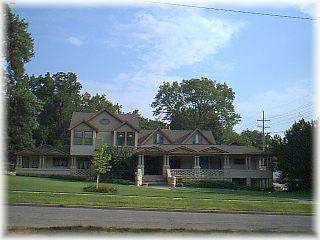The Leach House
category : Historic Buildings
 Built around 1890 by Louis B. Leach, a prominent early- day businessman, the house was made from memory to look like a Villa in the Suburbs of Messina, on the island of Sicily. Restoration and reconstruction of the Leach House was started in the spring of 1987 by Dr. Bill and Rose Ditto. It has since been completed and today stands fully restored and available for tours by appointment.
Built around 1890 by Louis B. Leach, a prominent early- day businessman, the house was made from memory to look like a Villa in the Suburbs of Messina, on the island of Sicily. Restoration and reconstruction of the Leach House was started in the spring of 1987 by Dr. Bill and Rose Ditto. It has since been completed and today stands fully restored and available for tours by appointment. The Leach House was built in two parts, the 2-story section on the east around 1890 and the 3-story on the west around 1904.
On the back of a post card dated 1907, Leach described his unique dwelling place; "Some of the peculiarities of the house are: There are 14 gables and 15 outside doors. Porch to the south 10 feet deep, with parapet stone wall, cement floor and 25 columns, and on the north a porch 6 feet deep. There are 15 practical living rooms above the basement, with 9 closets, bath room and linen room."
"The basement is divided by stone walls, into five apartments, including a hot water heating plant, laundry, ample cellar and storage for a year's fuel supply. A wealth of electric light in every room, and sparkling water from our most excellent city system-"
Supposedly, an under-ground tunnel ran from the structure southeast to Leach's Opera House and Sanitarium built by Leach in 1881-82.Purportedly, Leach used the tunnel to get to and from his Opera House during inclement weather and entertainers were said to have used the tunnel to get to the Leach House, where they sometimes stayed after performing. There is also a legend of an underground tunnel which ran north to the home Leach built for his sister.Yet another legend, was the existence of a "spirit room" in the house utilized by Leach in his later years when he was said to have become quite eccentric.
THE STAINED GLASS WINDOWS
The stained glass art windows located within are some of the finest examples of "mass produced" glass between the years 1885-1915. During this time there was a demand due to the interest of glass as a decorative and functional addition to the decor. Changes in the manufacturing of glass due to Tiffany, LaFarge, etc., and economical conditions of the time created this added interest in glass. Classic victorian is seen in the dining room with the colors to match as typically seen in panels during the early I 900's. Especially notable in the master bedroom is the pink glass, made by using gold salts intead of selenium, ordinarily used for hot glass-red, pink, orange, and yellow.
Elegance is reflected in design and materials selected for the breakfast room include 3/16" hand ground bevels which account for the intense prism effect. The standard now is 1/4" machine ground.
Again gold pink is used as an accent and red "antique" used as ribbons. This red glass is especially made by blowing into cylinders five feet or more, which are afterwards split open, flattened and annealed in a kiln as opposed to the background glass made by forcing liquid glass between rollers which impress a texture- This texture used throughout the house is now unavailable. Please note the shading in the background glass-extra layout time and special selection of glass! The stained glass windows on the second level as well as the breakfast room are exceptionally intricate which indicates they were made in the early 1900's.
The entry panel contains mottled red, a process not widely used until a little later. Also noticeable are the less complex pieces, a trend by 1908.
In 1911 the average wage of an art glass glazier was $3.00 a day and by the middle of World War I wages had fallen victim to the economic situation, thus ending this "boom" which has never regenerated.
Address: 5th Street, Wamego
Phone: 785-456-2040
Come visit us in Kansas, Kansas